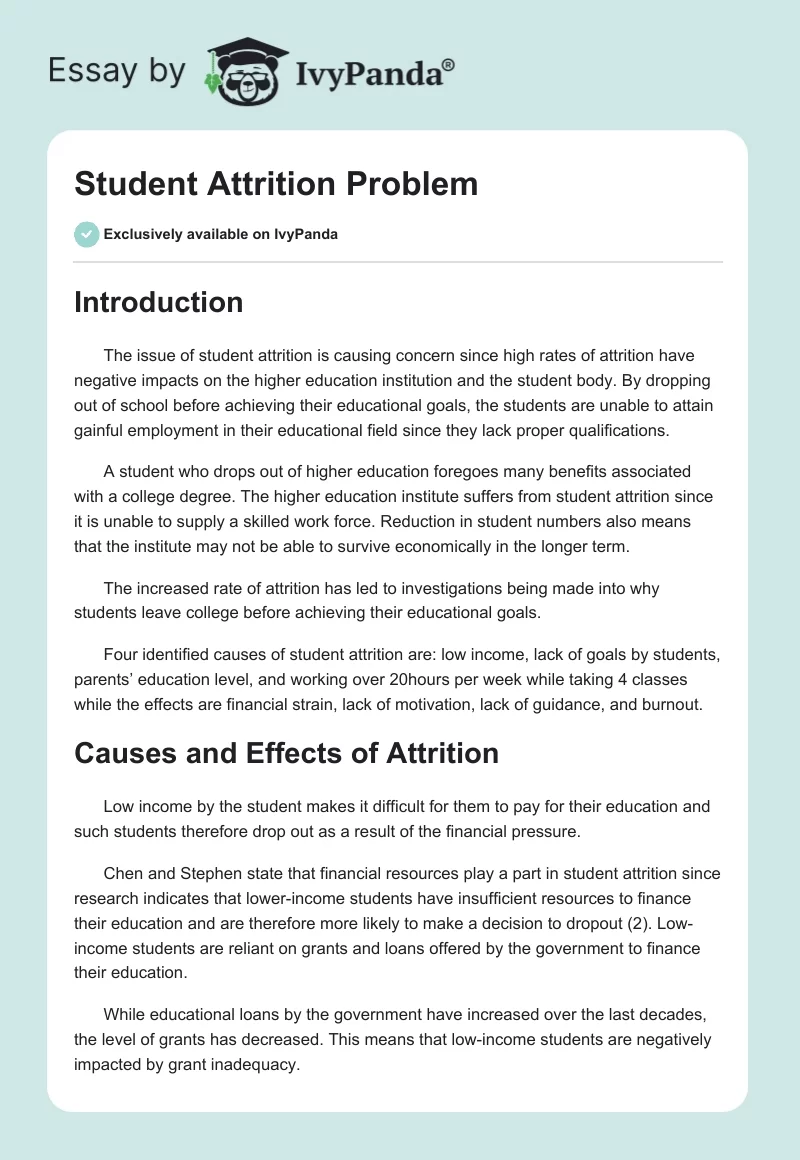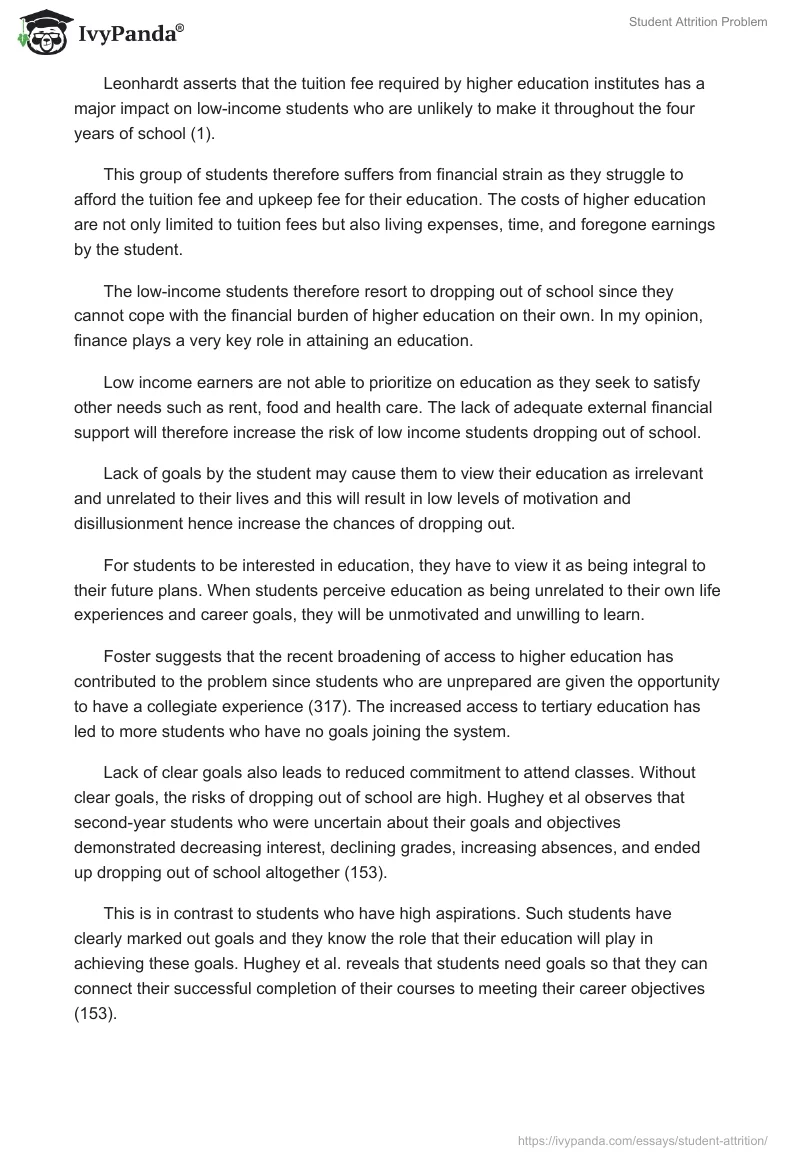Introduction
The issue of student attrition is causing concern since high rates of attrition have negative impacts on the higher education institution and the student body. By dropping out of school before achieving their educational goals, the students are unable to attain gainful employment in their educational field since they lack proper qualifications.
A student who drops out of higher education foregoes many benefits associated with a college degree. The higher education institute suffers from student attrition since it is unable to supply a skilled work force. Reduction in student numbers also means that the institute may not be able to survive economically in the longer term.
The increased rate of attrition has led to investigations being made into why students leave college before achieving their educational goals.
Four identified causes of student attrition are: low income, lack of goals by students, parents’ education level, and working over 20hours per week while taking 4 classes while the effects are financial strain, lack of motivation, lack of guidance, and burnout.
Causes and Effects of Attrition
Low income by the student makes it difficult for them to pay for their education and such students therefore drop out as a result of the financial pressure.
Chen and Stephen state that financial resources play a part in student attrition since research indicates that lower-income students have insufficient resources to finance their education and are therefore more likely to make a decision to dropout (2). Low-income students are reliant on grants and loans offered by the government to finance their education.
While educational loans by the government have increased over the last decades, the level of grants has decreased. This means that low-income students are negatively impacted by grant inadequacy.
Leonhardt asserts that the tuition fee required by higher education institutes has a major impact on low-income students who are unlikely to make it throughout the four years of school (1).
This group of students therefore suffers from financial strain as they struggle to afford the tuition fee and upkeep fee for their education. The costs of higher education are not only limited to tuition fees but also living expenses, time, and foregone earnings by the student.
The low-income students therefore resort to dropping out of school since they cannot cope with the financial burden of higher education on their own. In my opinion, finance plays a very key role in attaining an education.
Low income earners are not able to prioritize on education as they seek to satisfy other needs such as rent, food and health care. The lack of adequate external financial support will therefore increase the risk of low income students dropping out of school.
Lack of goals by the student may cause them to view their education as irrelevant and unrelated to their lives and this will result in low levels of motivation and disillusionment hence increase the chances of dropping out.
For students to be interested in education, they have to view it as being integral to their future plans. When students perceive education as being unrelated to their own life experiences and career goals, they will be unmotivated and unwilling to learn.
Foster suggests that the recent broadening of access to higher education has contributed to the problem since students who are unprepared are given the opportunity to have a collegiate experience (317). The increased access to tertiary education has led to more students who have no goals joining the system.
Lack of clear goals also leads to reduced commitment to attend classes. Without clear goals, the risks of dropping out of school are high. Hughey et al observes that second-year students who were uncertain about their goals and objectives demonstrated decreasing interest, declining grades, increasing absences, and ended up dropping out of school altogether (153).
This is in contrast to students who have high aspirations. Such students have clearly marked out goals and they know the role that their education will play in achieving these goals. Hughey et al. reveals that students need goals so that they can connect their successful completion of their courses to meeting their career objectives (153).
I agree with the suggestion that clear goals increase the chances of a student completing their degree. This is because if students can make this connection, they are more likely to persist in college and therefore demonstrate lower dropout rates. This motivation will also enable them to overcome the hardships and strains of college education.
The parent’s education level contributes to the individual student’s attrition risk with those students who have parents who experienced tertiary education being more likely to complete their education than those with parents with no tertiary education.
Studies by Malott and Bradeley indicate that the chances of students dropping out of school were reduced if the parents had some college education than if they were less educated (380). They reveal that first-generation college students were more likely to drop out of college as a result of numerous factors.
To begin with, these students are less likely to have the college experience encountered by their middle class peers. First generation students are likely to live at home and maintain the same peer groups they had before joining college.
In addition to this, they are less likely to get involved in school related extracurricular activities. Without such involvement, the students are unlikely to obtain the culture capital necessary for college success.
On the other hand, students whose parents have college education rank higher in scholarship. This might be because such parents will insist on their children achieving academic success. One result of not having college educated parents is that students lack the appropriate support.
For example, Mozella notes that first generation students do not have knowledge about timelines and deadlines for acquiring financial aid (841). Such students suffer from high anxiety and their parents are unable to help since they do not have any experience with college education.
I believe that parents play a key role in shaping the future of the children. College educated parents will be able to guide their children and encourage them to complete their education. They will also serve as role models of the future benefits of college education to their children.
Working more than 20 hours a week while taking 3 or 4 classes results in stress and burnout as many students find it increasingly hard to balance their work and school life. Johnson cites the difficulty to maintain a school-work balance as the major reason for dropping out of college by many students (1).
For most working students, maintaining employment is mandatory as the costs of college attendance are very high. Many students use the money they earn to help pay for their educational expenses and maintain themselves while in school. Others also have out of school financial obligations such as supporting their families.
As a result of this multiple financial obligations, students find it necessary to maintain employment while at school. Johnson reveals that when a choice has to be made between school and supporting the family, many opted to drop out of school (1). If more money is required, students will have to put in more work hours often at the expense of their studies.
Increased working hours have a negative impact on students’ grades. Specifically, the more the hours the student puts in the higher the negative effects on their grade. Lang documents that in a study on the impact of work on undergraduate students, 33% of the working students stated that work “much” or “greatly” interfered with their studies (244).
I believe that work commitments increase the burden of the student. It can lead to them having inadequate time to engage in school work. IF a student cannot balance their work and school life, they might decide to drop out of school especially if the job is being used to cater for the educational expenses.
Conclusion
While many education institutes hope to encourage students to succeed, the issue of attrition is hampering this goal. This paper identified low income, lack of goals by students, parents’ education level, and working over 20hours per week while taking 4 classes, as the four major causes of student attrition.
It also highlighted the effects of this causes which include financial strain, lack of motivation, lack of guidance, and burnout by the student. These factors increase the rate of student dropout. These issues must be addressed in order to reduce the dropout rates and therefore ensure that more students enjoy the benefits of a college degree.
Works Cited
Chen, Rong and Stephen DesJardins. “Exploring the Effects of Financial Aid on the Gap in Student Dropout Risks by Income Level.” Res High Educ 49.1 (2008): 1–18. Web.
Foster, Gigi. “Teacher effects on student attrition and performance in mass-market tertiary education.” High Education 60.1 (2010): 301–319. Web.
Hughey, Kenneth et al. The Handbook of Career Advising. Boston: John Wiley & Sons, 2012. Print.
Johnson, Jenna. Majority of college dropouts cite financial struggles as main cause. 2009. Web.
Lang, Brandon. “The similarities and differences between working and non-working students at a mid-sized American public university.” College Student Journal 12.2 (2006): 243-255. Web.
Leonhardt, David. Colleges are failing in graduation rates. 8 Sept. 2009. Web.
Malott, Curry and Bradley Porfilio. Critical Pedagogy in the Twenty-First Century: A New Generation of Scholars. NY: IAP, 2011. Print.
Mozella, Garcia. “When Hispanic students attempt to succeed in college, but do not.” Community College Journal of Research and Practice 34.1 (2010): 839–847. Web.


